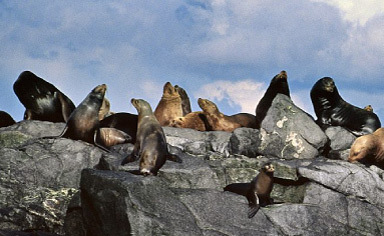|
Steller Sea Lions |
This project started with a simple idea. In the field, researchers can only work with
an animal for an hour or so. With the capacity of the SeaLife Center, animals could
be brought into the lab for much longer periods. Even though the Steller sea lion is
endangered, the Center has quarantine facilities that allow them to be brought in and
worked on in the lab - unique among endangered species. The juvenile Stellers stay for
six weeks, during which time they are implanted with life history transmitters that
record and store data. After being released, the transmitters stay with the animal.
When the animals die, the device will pop to the surface where it can be found by
GPS and the data downloaded, giving researchers a better idea about causes of mortality.
"This project has far exceeded all expectations," says Mike.
|
|
|
Dr. Michael Castellini moved to Alaska in 1989 in order to study marine mammals – what it takes for them
to live in the ocean, from both physiological and medical perspectives. For years this had required
fieldwork in order to observe the animals and get samples. The opening of the Alaska SeaLife Center meant
that marine mammals could be observed in captivity and brought in for testing and data sensor implants
and then released. (See the Steller Sea Lion Project, below.)
"Nothing quite beats sitting on a beach holding a brand new seal pup." |
In Alaska, marine mammals are co-managed between subsistence utilization and the Marine Mammal Protection
Act. While these two perspectives may be in conflict at times, there is agreement on the concern about
declines in population as well as impacts on the ecosystem from climate change and fishing. Mike's
research has been key in the understanding of what might be causing declines, and thus how to manage
these populations. "We have to use data that we have now to try to interpret backwards in time," says
Mike. "First we have to discover if animals in the field are healthy or not - how do you determine their
relative health?"
What appealed to Mike about working with marine mammals was that they offer a unique comparative view of
how physiology works. He saw how he could exploit that comparative view to understand oxygen chemistry,
adaptation to pressure, adaptation to cold. Other scientists have looked in additional areas, such as
hydrodynamics or cognitive issues.
Mike has studied Steller sea lions, whales, sea otters and other mammals, what types of food and fuel
keep them going, how they digest fish, and starvation chemistry. More recently he has studied how they
hold their breath when they sleep, in conjunction with Sudden Infant Death Syndrome (SIDS) research
being done at the National Institutes of Health (NIH). He has been out on beaches from Barrow to the
Aleutians, looking at effects from the Exxon Valdez oil spill on animals' blood chemistry. "It's
always been an adventure," says Mike. "And I'd do it all over again."




